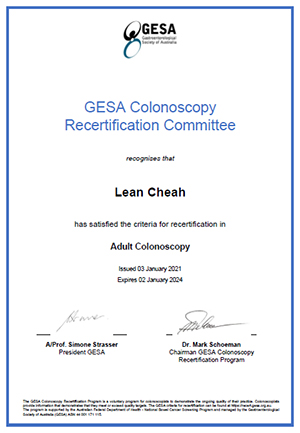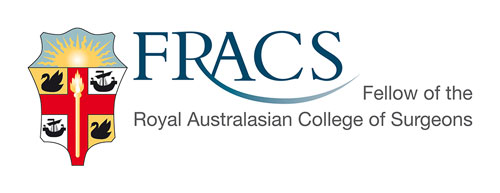COLONOSCOPY
A colonoscopy is an examination of the large intestine using a thin flexible video endoscope.
BENEFITS
1. Direct visualization of pathology sucy as polyps in the bowel, bowel cancer, inflammation of the bowel(colitis) and abnormal blood vessels(angiodysplasia)
2. Biopsies can be taken and sent to the pathology lab for testing.
3. Polypectomy : If there are polyps - most can be removed at the same time(ie by snaring or piecemeal biopsies)
4. Haemorrhoids - if there are haemorrhoids, these can be banded at the same time. Banding is good a reducing bleeding from haemorrhoids and can also reduce the size of a prolapsing haemorrhoids.
The bands are applied above the anal canal and cuts off the blood supply to the haemorrhoids. These bands usually fall off in 1 to 14 days.
After the banding, one can get a sensation of wanting to go to the toilet as the rectal lining is stretched(akin to when the rectum is distended with faeces) - but one should not need to go to the toilet if one has already had a bowel preparation.
Local anaesthesia will also be injected(the branches of the supplying pudendal nerve will be blocked) to reduce pain in case the band pulls on the lining of the anal canal or vaginal wall(especially of the haemorrhoids are large). A Proctosedyl suppository and Lignocaine gel may also be given.
After the banding it is important to take a high fibre diet, keep the stools soft(lots of water and if needed, laxatives) and avoid prolonged sitting on the toielt. Using a haemorrhoid ointment to lubricate the anal canal before a hard bowel action may also help.
Risks - pain/discomfort(rarely if severe, the bands may need to be removed), bleeding
(Please check that your endoscopist will treat the haemorrhoids if found during the colonoscopy - Dr Cheah would do this routinely if this has been discussed preop, but many endoscopists refer this on to surgeons like Dr Cheah to treat)
5. Anal fissure - Under the same sedation, the anal canal can be examined with a proctoscope to identify the anal fissure. The proctoscope can also gently dilate the anal canal in a controlled fashion. If you already have a severe pain on passing motions, this will also cause a similar pain. Local anaesthesia may also be injected to reduce the pain when you wake up.
ALTERNATIVES TO COLONOSCOPY
1. CT colonography & Barium enema - these are radiological investigations. Advantage - not as invasive, not requiring sedation. Disadvantage - not able to do any biopsy or polypectomy, a small polyp may be missed, mucosal abnormality eg colitis, angidysplasia may be missed, exposure to radiation, poor views especially of lower rectum due to balloon catheter inserted to perform the examination
2. Faecal occult blood test(FOBT) - this is good for screening if one does not have any symptoms yet. Not recommended if one already has rectal bleeding.
3. Capsule endoscopy(Pill Camera) - good for imaging small bowel. But may miss lesions due to the randomness of pictures being taken
4. Faecal colon cancer DNA test - been trialled at present, more common in the future
PROCEDURE
Sedation will be given by the anaesthetist during the procedure.
After the colonoscopy, you would need to be observed in recovery before being discharged. You may feel some bloating, abdominal cramps/lower back pain, urge to go to the toilet or pass flatus.
It is important to have someone drive you home after the procedure
You should not drive or operated heavy machinery or sign any legal documents for 12 hours after the procedure.
A report will be given to you to give to your referring doctor and any pathology results(from St Vincents Pathlogy at Coburg Endoscopy, Melbourne Pathology at Western Gastroenterology, Dorevitch at Mitcham and Endopath at John Fawkner) will also be copied to your referring doctor
RISKS
Intolerance of the bowel preparation or reaction to the anaesthetic medications(nausea & vomiting).
Incomplete colonoscopy(less than 5%) - sometimes it is not possible to reach the caecum or the terminal ileum safely. This can be due to looping of the bowel, a long tortous colon, a tight angle of the colon making it unsafe to proceed or narrowing of the bowel from cancer or diverticular disease. In this case, a CT colonography is usually recommended to view the rest of the bowel.
Missing views of a polyp - a polyp may be missed if very small, covered by faeculent material(hence it is important to have a good bowel preparation) or hidden behind a mucosal fold or within a diverticulum/appendix
Perforation (hole in the bowel) or major bleeding from the bowel are rare(1 in 1000; but risks increases if a large polyp is removed or there are adhesions or cancer outside the colon holding down the bowel causing a tear when the scope is passed) If they occur, surgery(laparotomy, bowel resection or control of bleeding from the spleen) or rarely blood transfusion may be required.
Other risks include - infection(sepsis), aspiration of the stomach contents(hence it is important not to have any clear fluids 2 hours prior to the sedation), incidental heart attack/stroke/death, slowing of heart rate during the procedure(from insufflation of the bowel with air/carbon dioxide gas)
If is important to seek urgent medical attention if you have severe abdominal pain, heavy bleeding, black stools or fever in the days after the procedure.
Consult with your General Practitioner about stopping any blood-thinning medications before the procedure:
1. Warfarin(Coumadin, Marevan) - 4 days before
2. Clopidogrel(Plavix, Iscover), Prasugrel (Effient),Ticagrelor (Brilinta) : 1 week before
3. Dipyridamole(Asasantin, Persantin) : 1 week before
4. Xarelto (Rivaroxaban), Pradaxa (Dabigatran), Apixaban(Eliquis)
5. Ticlid ® (ticlopidine hydorchloride)
6. Aspirin - you can usually to continue this although there is increased risks of bleeding
It is important to discuss with the prescribing doctors - Risks of stopping include stroke, heart clots/deep venous thrombosis/pulmonary embolism, blockage of coronary stents. Sometimes Clexane injections need to be given up to day before the scope eg once INR is less than 2 if patient has a mechanical heart valve
BOWEL PREPARATION
The colon must be empty so that a clear view of the lining can be obtained in order not to miss any polyps
1 DAY BEFORE THE PROCEDURE
Take only a low fibre diet(without any seeds(these can block up the scope), avoid skins of fruits, corn etc)
Drink clear fluids only after a light early dinner(best to have this before 7pm).
Take 3 sachets of Picoprep(these come in a box and can be purchased from the pharmacy) - mix each sachet with a glass of warm water.
For a MORNING colonoscopy - take the Picoprep at:
8pm
10pm
and the last one between midnight and 6 hours before the procedure(the bowel will be cleaner if you take it closer to the procedure)
For an AFTERNOON colonoscopy - take the Picoprep at:
10pm the night before
8am in the morning
and 10am in the morning
Remember to drink glasses of CLEAR FLUIDS up to 2 hours before the colonoscopy to help wash out the bowel(in the last 4 hours - just drink 1-2 glasses an hour)
CLEAR FLUIDS include - cordial, energy drinks(Gatorade, Powerade), cordial, soft drinks, clear apple juice(without the pulp white material), clear soup, tea without milk, plain water
(Avoid any milk or coffee or alcohol)
Alternatives to Picoprep include - Picolax, Fleet, Prep Kit C
If you have renal failure - another prep is recommended : eg Glycoprep
If you have severe constipation and have previously had poor bowel prep : additional bowel prep may be needed and you may need to be on clear fluids from the morning before the procedure.
If you are mainly having haemorrhoids banded and do not want the whole of your colon examined - Fleet enema alone can be given 2 hours before the procedure half an hour apart. The endoscopist will try to pass the scope up as far as views allow.



